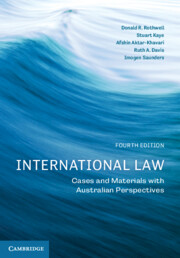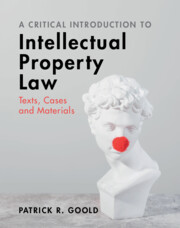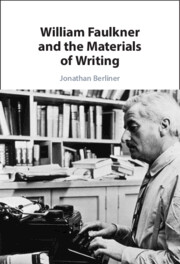Refine search
Actions for selected content:
42 results
3 - Materials
-
-
- Book:
- Explaining the History of American Foreign Relations
- Published online:
- 24 October 2025
- Print publication:
- 13 November 2025, pp 64-81
-
- Chapter
- Export citation
Experimental study of electrical arc phenomena in electrodes with pure and coated materials to be used in aerospace power connectors
-
- Journal:
- The Aeronautical Journal , First View
- Published online by Cambridge University Press:
- 08 September 2025, pp. 1-18
-
- Article
- Export citation

International Law
- Cases and Materials with Australian Perspectives
-
- Published online:
- 26 July 2025
- Print publication:
- 31 July 2025
-
- Textbook
- Export citation
12 - Organisation and Management
-
- Book:
- Teaching Modern Languages
- Published online:
- 04 September 2025
- Print publication:
- 12 June 2025, pp 189-201
-
- Chapter
- Export citation
2 - Quantum chemistry
- from Part I - Areas of application
-
- Book:
- Quantum Algorithms
- Published online:
- 03 May 2025
- Print publication:
- 24 April 2025, pp 29-50
-
- Chapter
-
- You have access
- Open access
- Export citation
1 - Ship Structures and Structural Design Practice
-
- Book:
- Global Strength of Ships
- Published online:
- 20 March 2025
- Print publication:
- 03 April 2025, pp 1-45
-
- Chapter
- Export citation
Chapter 8 - Empirical Research on College Faculty Thinking and Action in a Minority Serving Institution
-
- Book:
- Cultural Learning in Urban Schools and Minority Serving Institutions
- Published online:
- 20 March 2025
- Print publication:
- 03 April 2025, pp 94-104
-
- Chapter
- Export citation
Securitizing high-technology industries: South Korea–Japan dispute over materials–parts–equipment products – CORRIGENDUM
-
- Journal:
- Business and Politics , First View
- Published online by Cambridge University Press:
- 16 September 2024, p. 1
-
- Article
-
- You have access
- Open access
- HTML
- Export citation

A Critical Introduction to Intellectual Property Law
- Texts, Cases and Materials
-
- Published online:
- 17 May 2024
- Print publication:
- 06 June 2024
-
- Textbook
- Export citation
Tactility in perception of biobased composites
-
- Journal:
- Proceedings of the Design Society / Volume 4 / May 2024
- Published online by Cambridge University Press:
- 16 May 2024, pp. 1467-1476
-
- Article
-
- You have access
- Open access
- Export citation
The Nascence of Clay Minerals
-
- Journal:
- Clays and Clay Minerals / Volume 33 / Issue 3 / June 1985
- Published online by Cambridge University Press:
- 02 April 2024, pp. 161-172
-
- Article
- Export citation
Securitizing high-technology industries: South Korea–Japan dispute over materials–parts–equipment products
-
- Journal:
- Business and Politics / Volume 27 / Issue 4 / December 2025
- Published online by Cambridge University Press:
- 11 March 2024, pp. 504-520
-
- Article
-
- You have access
- Open access
- HTML
- Export citation
3 - Association and the Division of Labour
- from Part I - Interdependence and the Economic Constitution
-
- Book:
- The Constitution of Political Economy
- Published online:
- 03 August 2023
- Print publication:
- 17 August 2023, pp 62-95
-
- Chapter
- Export citation
7 - Material Conditions
- from Part III - Deep Pluralism
-
- Book:
- Making Global Society
- Published online:
- 27 July 2023
- Print publication:
- 10 August 2023, pp 337-348
-
- Chapter
- Export citation
16 - The Three-Legged Stool Approach
-
- Book:
- How to Talk Language Science with Everybody
- Published online:
- 17 May 2023
- Print publication:
- 29 June 2023, pp 192-202
-
- Chapter
- Export citation

William Faulkner and the Materials of Writing
-
- Published online:
- 24 May 2023
- Print publication:
- 05 January 2023
Part VI - Technology, Energy, Materials, and Socio-Environmental Research
-
- Book:
- Foundations of Socio-Environmental Research
- Published online:
- 18 November 2022
- Print publication:
- 08 December 2022, pp 645-652
-
- Chapter
- Export citation
1 - Fundamentals on Synthesis and Properties of Ultrananocrystalline Diamond (UNCD™) Coatings
-
-
- Book:
- Ultrananocrystalline Diamond Coatings for Next-Generation High-Tech and Medical Devices
- Published online:
- 08 July 2022
- Print publication:
- 21 July 2022, pp 1-85
-
- Chapter
- Export citation
Reflections on the sequence of musical development
-
- Journal:
- British Journal of Music Education / Volume 39 / Issue 1 / March 2022
- Published online by Cambridge University Press:
- 30 March 2022, pp. 44-50
- Print publication:
- March 2022
-
- Article
-
- You have access
- Open access
- HTML
- Export citation
Musical development then and now: in conversation with June Boyce-Tillman
-
- Journal:
- British Journal of Music Education / Volume 39 / Issue 1 / March 2022
- Published online by Cambridge University Press:
- 30 March 2022, pp. 51-66
- Print publication:
- March 2022
-
- Article
-
- You have access
- Open access
- HTML
- Export citation
